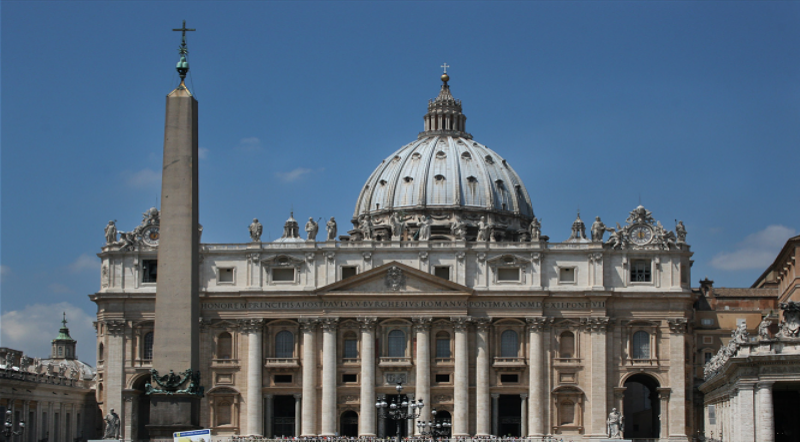Source For This Article
TheStreet
How Rich Is the Catholic Church? It's Impossible to Tell
How much real estate does the Catholic Church own? What are its equity holdings? These questions, and more, not answered.
NEW YORK (TheStreet) -- Feeling guilty about investing in "sin" stocks, like makers of guns, cigarettes and alcohol products? Don't. Over the course of its history of investing, the Catholic Church has done much worse.
In the 1960s, Italian media uncovered evidence that the Vatican had invested in entities that conflict directly with the church's holy mission, including Istituto Farmacologico Serono, a pharmaceutical company that made birth control pills, and Udine, a military weapons manufacturer. There have also been unconfirmed rumor of church money in firearms manufacturer Beretta and companies with activities in gambling and pornography. It has been linked to dealings with Nazi gold during World War II as well.
The Catholic Church has a history of corruption, and it is a notoriously opaque institution. Sexual abuse accusations (and the consequent cover-ups) have put it in the headlines most recently, but it has been at the center of numerous scandals over the years, ranging from accusations of ties to the mafia in Rome to allegations of stealing babies in Chile and Spain.



Pope Francis, who visits the U.S. this week, has been credited with bringing enormous change to the Catholic Church since his election to the papacy in 2013, including when it comes to the Church's finances.
Francis has made major overhauls at the Institute for the Works of Religion, commonly referred to as the Vatican Bank, a privately held financial institution located inside Vatican City. Founded in 1942 with the intention of safeguarding and administering property intended for works of religion or charity, the bank only accepts deposits from Catholic institutions and individual account-holders who are tied to the church. It then manages that money and provides services much as other banks do.
The bank has faced numerous scandals over the years. One of the most significant was the 1982 collapse of Banco Ambrosiano, of which the Vatican Bank was the main shareholder. The Italian bank went under after making what was estimated at the time to be $1.4 billion in unsecured loans to dummy companies in Latin America. At the center of an investigation into its dealings was what The New York Times described as a "close but ambiguous" relationship between the Ambrosiano's president, Roberto Calvi, and Archbishop Paul Marcinkus, the head of the Vatican Bank. In the wake of the scandal, Calvi was found dead, hanged from a bridge in what is largely believed to be a faked suicide.
Just recently, the Vatican was caught up in yet another financial scandal, when Monsignor Nunzio Scarano, who was an accountant at the bank that managed the Church's real estate investments, was arrested when he tried to smuggle €20 million ($26 million in 2013, when the plot was uncovered) into Italy, allegedly on behalf of the d'Amico shipping family. He told the authorities that he stood to gain €2.5 million on the deal. Investigators were first alerted to him when he reported paintings stolen from his apartment and police discovered a luxurious pad packed to the ceiling with expensive art and furnishings, which the Monsignor, who draws a small salary as a member of the clergy, claimed were gifts.
Things have come a long way since even then. In fact, Scarano's arrest could be seen as part of the move toward reform.
The Vatican passed its first legislation against money laundering and terrorist group funding in 2011. At the Vatican Bank, Pope Francis has brought in new leadership, increased transparency and limited access to the bank to diocese and other Catholic organizations to further fight against money laundering. Under his watch, the bank also disclosed its very first annual financial report in 2013 (the bank released a second annual report last year).
Journalist Paul Vallely, who has written several books about the Pope, said on NPR of the bank's new transparency, "They heard I was writing another edition of the book and said, well, do you want to come in and we'll show you what's going on here? And, I mean, that was in itself an amazing change. The Vatican bank's never had a press officer in the past. Its job was keeping journalists away, not welcoming them in and saying, let's show you how we're going about the reform process."
Vallely called the reforms that Francis has enacted "completely radical": closing 3,000 of the bank's 19,000 accounts; alerting authorities to 200 suspicious transactions; and cleaning house of any bank functionaries who seemed to resist changes.
Yet, "They're having a tough time moving into the world of 21st century transparency," said Gerald Posner, an American investigative journalist and the author of the 2015 book God's Bankers: A History of Money and Power at the Vatican. "Think of the Vatican Bank as sort of the equivalent of the Federal Reserve, we know everything the Fed does, we get minutes from the meetings. Here, they're investing literally billions of dollars, but it's always been in the dark, and they didn't know how to operate any other way. They're being dragged into the 21st century because, since they went with the euro at the turn of the century, Brussels and the European Union are now sending in evaluators to see how they're doing."
Despite the reforms, finding out where the Catholic Church is actually investing is easier said than done.
The Vatican Bank's 2014 report lists its total assets at €3.2 billion ($3.6 billion) as of December 31, including €2.6 billion in securities investments, more than 90% of which is in government bonds. As to the specifics of its exact holdings, it doesn't dive into much more detail. But, because of the distributed operations of the Church, this is just the tip of the iceberg. Churches in countries all over the world operate their own finances under the laws of those countries, some of which require disclosures.
In the United States, where financial transparency is strong and corruption not as common as in some other regions of the world, deciphering where the Catholic Church is invested is no simple feat. In fact, thanks to the way the U.S. legal system is set up, it may be the place where the church's holdings are most opaque.




